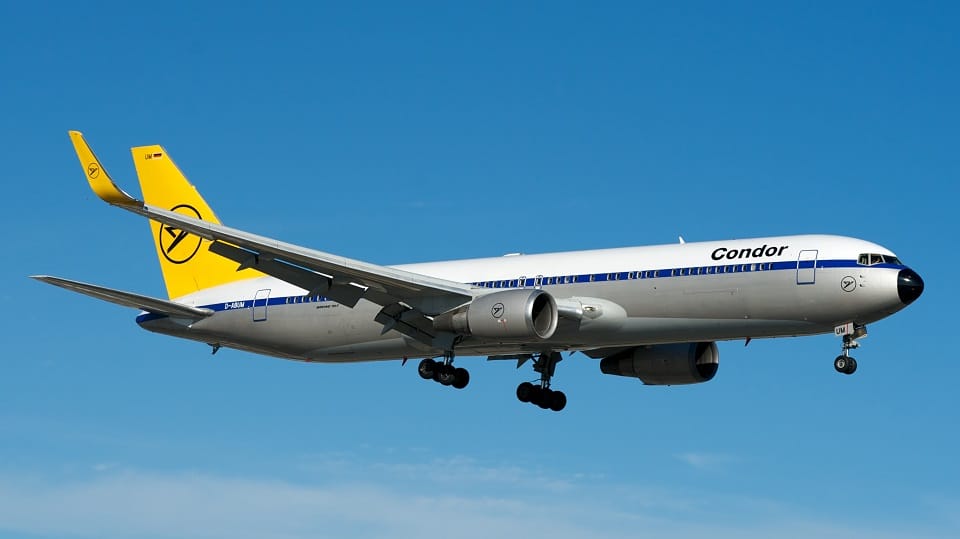Airlines
Retro-Liveried Condor Boeing 767-300 to Undergo Freight Conversion in China

Condor Airlines, a well-known German leisure carrier, has revealed plans to convert one of its Boeing 767-300 planes to a freighter in China. The unique aspect of this conversion lies in the retro livery that will adorn the aircraft, paying homage to its rich aviation history. The decision to carry out the conversion in China stems from the country’s expertise in aircraft modifications and its thriving air cargo industry.
Condor Airlines, known for its long history in the aviation sector, has decided to convert one of its Boeing 767-300 passenger jets into a specialized freighter. This move is in response to rising demand for air cargo services, particularly in light of the worldwide e-commerce boom.
As per a tweet from Steve Giordano, the Condor Boeing 767-300ER, currently stored at Phoenix Goodyear Airport (GYR) in Arizona, United States (US), is scheduled to be ferried to Guangzhou, China for its freighter conversion.
The retro-liveried Condor Boeing 767-300 freighter will join the airline’s increasing fleet upon completion of the conversion, enhancing its cargo operations and contributing to its overall growth strategy. The aircraft’s striking design, with its eye-catching retro livery, aims to draw see both on the ground and in the air, providing Condor with a unique branding opportunity and further boosting its presence in the freight sector.
Germany’s Condor airline with a new brand identity(Opens in a new browser tab)
Condor Airlines exhibits its versatility and creativity in reacting to the increasing needs of the aviation sector with this conversion project. Condor mixes the old and the new by reusing a well-known passenger aircraft and keeping its historical appeal through the vintage livery, paying honour to its heritage while embracing the future of air cargo service.

Airlines
Air India Rolls Out A350s for Delhi-New York JFK and Newark Routes

In a major development for North American travelers, Air India has announced the deployment of its state-of-the-art Airbus A350-900 aircraft on two key routes: Delhi to New York and Delhi to Newark.
The service on the Delhi-New York route will commence on November 1, 2024, while the Delhi-Newark route will see its inaugural flight on January 2, 2025.
The introduction of the air india a350 will bring significant enhancements to Air India’s offerings, particularly with the launch of its Premium Economy class. air india retrofit This new class will feature 24 wide seats arranged in a 2-4-2 configuration, providing passengers with extra legroom and a more comfortable flying experience.
Soon, Air India aircraft will feature onboard WiFi & all-new cabins: Click here
“We are encouraged by the positive guest feedback we have received from the domestic deployment of our air india a350 interior to offer our hero product on the Delhi-New York JFK and Delhi-Newark routes. This is a significant leap forward for our U.S. operations that also underscores our commitment to continuous improvement,” said Campbell Wilson, Chief Executive Officer & Managing Director of Air India.
The A350’s Business class will set new standards with 28 private suites, each equipped with full-flat beds, direct aisle access, and personal wardrobes. Economy class will be configured to accommodate 264 passengers in a 3-4-3 layout. Across all cabins, passengers will enjoy the latest Panasonic eX3 in-flight entertainment system, offering over 2,200 hours of content.
Air India’s First A350-900: Interior, Routes, &Inflight Features: Click here
This strategic deployment marks a notable enhancement in Air India’s U.S. operations, with 60% of its flights to the U.S. now featuring new or upgraded cabin interiors. The air india new international routes currently operates 51 weekly flights to five U.S. destinations: New York JFK, Newark, Washington DC, Chicago, and San Francisco.
The revamped cabins, advanced in-flight entertainment systems, and improved service standards represent air india wifi commitment to providing a superior travel experience. “We believe this enhanced offering will solidify Air India’s position as a leading carrier and attract travellers seeking a world-class flying experience between India and the United States,” the airline stated.
Seats on these flights are now available for booking on Air India’s website, mobile app, and through travel agents, ensuring that passengers can easily plan their journeys on these newly upgraded routes.
Air India Economy vs Qatar airways economy: which is best?:Click here
-

 Travel1 week ago
Travel1 week agoAir India to Expand US Operations with Three New Routes After a Decade
-

 Travel2 weeks ago
Travel2 weeks agoWhy We Should Avoid These Stamps in a Passport
-

 Airlines1 month ago
Airlines1 month agoInvestigations Reveal Fake Chinese Titanium in Boeing and Airbus Jets
-

 Tech4 weeks ago
Tech4 weeks agoChina’s CATL Plans 1,800-Mile Electric Plane Launch by 2027
-

 Airport3 days ago
Airport3 days agoTop 10 Largest Airports in the World by Size
-

 Aerospace4 weeks ago
Aerospace4 weeks agoChina’s Fighter Jets Turn Wings into Autonomous Drones
-

 Airlines4 days ago
Airlines4 days agoAir India Rolls Out A350s for Delhi-New York JFK and Newark Routes
-

 Defence3 weeks ago
Defence3 weeks agoBoeing Enhances Chinook with New Engines and Block II Upgrades at $96 Million







